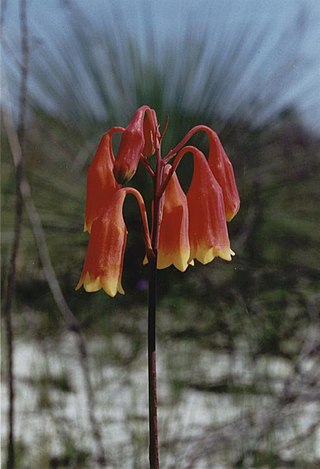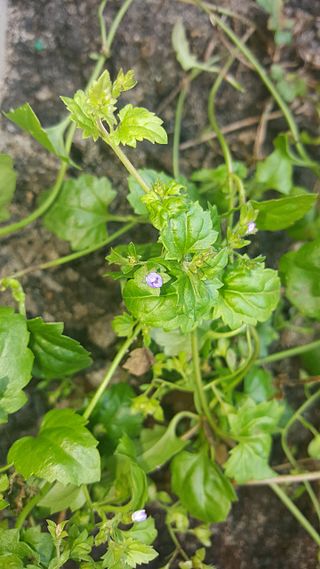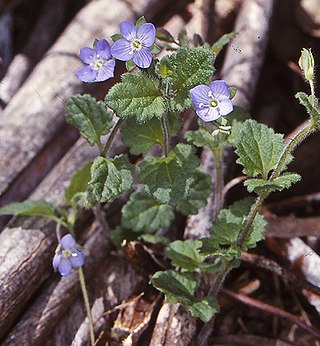
Prostanthera incisa, commonly known as cut-leaf mint-bush or native thyme, is a species of flowering plant in the family Lamiaceae and is endemic to south-eastern continental Australia. It is an erect, strongly aromatic, openly branched shrub with hairy, densely glandular branches, egg-shaped to oblong leaves, and pale mauve to mauve flowers.

Prostanthera rotundifolia, commonly known as round-leaved mintbush or round-leaf mint-bush is a species of flowering plant in the mint family Lamiaceae, and is endemic to south-eastern Australia. It is an erect shrub with aromatic branches covered with short hairs and glands, egg-shaped to more or less round leaves and purple to mauve or pinkish flowers on the ends of branchlets.

Dampiera is a genus of about 70 species of flowering plants in the family Goodeniaceae, all of which are endemic to Australia. Plants in the genus Dampiera are subshrubs or herbs with sessile leaves, flowers with five small sepals and blue, violet or pink, rarely white, two-lipped flowers.

Blandfordia grandiflora, commonly known as Christmas bells, is a flowering plant endemic to eastern Australia. It is a tufted perennial herb with narrow, channelled, linear leaves and between two and twenty large, drooping, bell-shaped flowers. The flowers are red with yellow tips, or sometimes entirely yellow. It is one of four species of Blandfordia known as Christmas bells, this one growing on the coast and nearby ranges between Sydney in New South Wales and Fraser Island in Queensland.

Lobelia purpurascens, commonly known as white root or purplish pratia, is a flowering plant in the family Campanulaceae of eastern Australia. It is a small herbaceous, scrambling plant with white to pale pink flowers.

Dampiera linearis, commonly known as common dampiera or wedge-leaved dampiera, is an erect perennial herb in the family Goodeniaceae. The species, which is endemic to the south-west of Western Australia, grows to between 15 and 60 cm high, with its blue to purple flowers appearing between July and December. It adapts readily to cultivation, particularly containers such as hanging baskets.

Dampiera stricta commonly known as blue dampiera, is a flowering plant in the family Goodeniaceae. It is a small sub-shrub with variable leaves and mostly blue, mauve or purple flowers.

Parsonsia straminea, commonly known as common silkpod or monkey rope, is a woody vine of the dogbane family, Apocynaceae. It occurs in the states of New South Wales and Queensland in Australia.

Prostanthera ovalifolia, commonly known as the oval-leaf mintbush or purple mintbush, is a species of flowering plant in the family Lamiaceae and is endemic to south-eastern continental Australia. It is an erect shrub with egg-shaped leaves and groups of mauve to deep blue-purple flowers arranged in groups at the ends of branchlets.

Ajuga australis, commonly known as Austral bugle, is a herbaceous flowering plant native to Eastern Australia. First described by Robert Brown, it is occasionally seen in horticulture.

Cryptostylis erecta, commonly known as the bonnet orchid or tartan tongue orchid , is an orchid endemic to south eastern Australia. A small and common plant, it has dark green lance-shaped to egg-shaped leaves and up to twelve greenish flowers with a large, bonnet-like or hood-like, lilac-coloured labellum with a network of purple veins.

Marsdenia suaveolens, commonly known as the scented milk vine, is a small vine found in New South Wales, Australia. It is found in a variety of habitats in relatively high rainfall areas, from Bega to Port Macquarie. The original specimen was collected at Sydney on 11 May 1802.

Prostanthera denticulata, commonly known as rough mint-bush, is a species of flowering plant in the family Lamiaceae and is endemic to coastal New South Wales. It is a straggling to almost prostrate, aromatic shrub with narrow egg-shaped leaves and purple to mauve flowers arranged in leaf axils or on the ends of branchlets.

Lyperanthus suaveolens, commonly called brown beaks, is a species of orchid that is endemic to the eastern states of Australia.

Patersonia sericea, commonly known as purple flag or silky purple-flag is a species of plant in the iris family Iridaceae and is endemic to eastern Australia. It is a densely-tufted perennial herb with linear, sword-shaped leaves, broadly egg-shaped, bluish-violet tepals and an oval capsule.

Veronica plebeia, commonly known as creeping- or trailing speedwell, is a species of flowering plant belonging to the family Plantaginaceae. It is native to Australia and New Zealand.

Veronica calycina, commonly known as hairy speedwell or cup speedwell, is a flowering plant in the family Plantaginaceae. It is a trailing perennial with dark green leaves, purple-blue flowers and is endemic to Australia.

Persicaria decipiens, commonly known as slender knotweed, is a species of flowering plant native to Australia and Asia.

Xyris gracilis, commonly known as slender yellow-eye, is a species of flowering plant in the family Xyridaceae and is endemic to eastern Australia. It is a tufted herb with linear leaves with 5 to 8 flowering stems with bright yellow flowers.
Chloanthes glandulosa is a species of flowering plant in the family Lamiaceae. It is a small shrub with wrinkled leaves and greenish-yellow tubular flowers. It is endemic to New South Wales.


















